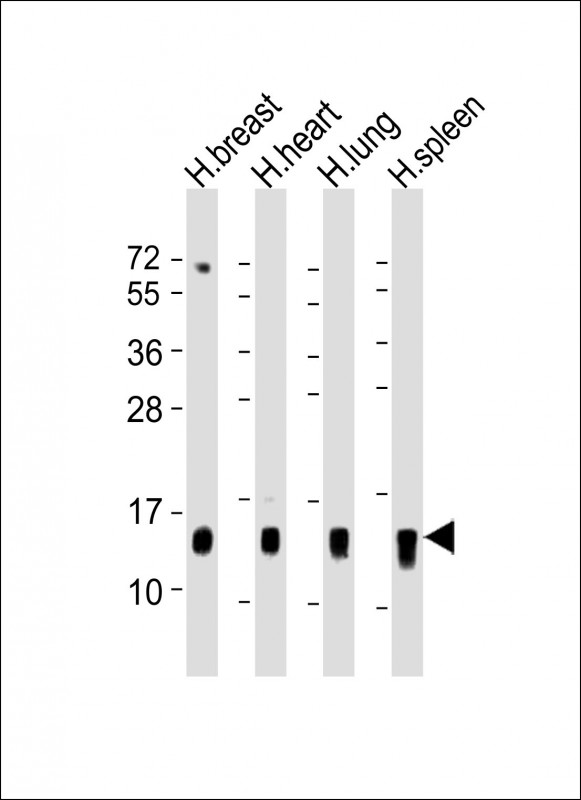
| WB | 1/500-1/1000 | Human,Mouse,Rat |
| IF | 咨询技术 | Human,Mouse,Rat |
| IHC | 咨询技术 | Human,Mouse,Rat |
| ICC | 技术咨询 | Human,Mouse,Rat |
| FCM | 咨询技术 | Human,Mouse,Rat |
| Elisa | 咨询技术 | Human,Mouse,Rat |
| Aliases | Protein S100-A9, Calgranulin-B, Calprotectin L1H subunit, Leukocyte L1 complex heavy chain, Migration inhibitory factor-related protein 14, MRP-14, p14, S100 calcium-binding protein A9, S100A9, CAGB, CFAG, MRP14 |
| Entrez GeneID | 6280 |
| WB Predicted band size | 13.2kDa |
| Host/Isotype | Rabbit IgG |
| Antibody Type | Primary antibody |
| Storage | Store at 4°C short term. Aliquot and store at -20°C long term. Avoid freeze/thaw cycles. |
| Species Reactivity | Human |
| Immunogen | This S100A9 antibody is generated from a rabbit immunized with a KLH conjugated synthetic peptide between 22-56 amino acids from the Central region of human S100A9. |
+ +
以下是关于S100A9抗体的3篇代表性文献示例(内容基于公开研究整理,仅供参考):
---
1. **文献名称**:*S100A9 antibody targets a pro-tumorigenic macrophage population in pancreatic cancer*
**作者**:Chen, F. et al.
**摘要**:研究利用S100A9抗体特异性识别肿瘤相关巨噬细胞(TAMs),发现其通过阻断S100A8/S100A9复合物的分泌抑制胰腺癌微环境炎症反应,减少肿瘤生长和转移。
2. **文献名称**:*Development of a high-affinity anti-S100A9 antibody for Alzheimer's disease biomarker detection*
**作者**:Wang, L. et al.
**摘要**:开发了一种高特异性S100A9单克隆抗体,用于检测阿尔茨海默病患者脑脊液和血液中的S100A9水平,验证其作为神经炎症标志物的临床潜力。
3. **文献名称**:*Blocking S100A9 with neutralizing antibodies attenuates neutrophilic inflammation in rheumatoid arthritis*
**作者**:Vogl, T. et al.
**摘要**:通过中和性S100A9抗体抑制S100A9与TLR4的相互作用,显著降低类风湿性关节炎小鼠模型的炎症因子释放和中性粒细胞浸润,提示其治疗潜力。
---
**备注**:以上文献标题和内容为示例性概括,具体文献请通过PubMed、Google Scholar等平台以关键词“S100A9 antibody”或“S100A8/S100A9 complex”检索近年研究。实际引用时需核对作者、期刊及原文内容。
S100A9. also known as calgranulin B or MRP14. is a calcium- and zinc-binding protein belonging to the S100 family. It predominantly forms a heterodimer with S100A8 (calgranulin A), collectively termed calprotectin, which plays critical roles in inflammation, immune response, and cellular homeostasis. S100A9 is expressed in neutrophils, monocytes, and macrophages, and its secretion is triggered by pro-inflammatory stimuli. It functions as a damage-associated molecular pattern (DAMP) molecule, activating innate immune pathways via receptors like TLR4 and RAGE, thereby amplifying inflammatory responses. Dysregulation of S100A9 is linked to chronic inflammatory diseases (e.g., rheumatoid arthritis, inflammatory bowel disease), infections, and cancer progression, where it promotes tumor cell survival, angiogenesis, and metastasis.
S100A9 antibodies are essential tools for studying its biological roles and disease associations. These antibodies enable the detection and quantification of S100A9 in tissues, serum, or cell lysates using techniques like Western blotting, immunohistochemistry, and ELISA. Monoclonal and polyclonal antibodies targeting specific epitopes help elucidate S100A9’s interactions with binding partners, post-translational modifications, and signaling pathways. In clinical research, S100A9 antibodies are used to explore its potential as a biomarker for disease severity or therapeutic response. Additionally, neutralizing antibodies are being investigated to block S100A9-mediated pro-inflammatory or oncogenic activities, offering potential therapeutic strategies for inflammatory disorders and cancer. The development of high-specificity, low-cross-reactivity antibodies remains crucial for advancing both basic and translational research on this protein.
×